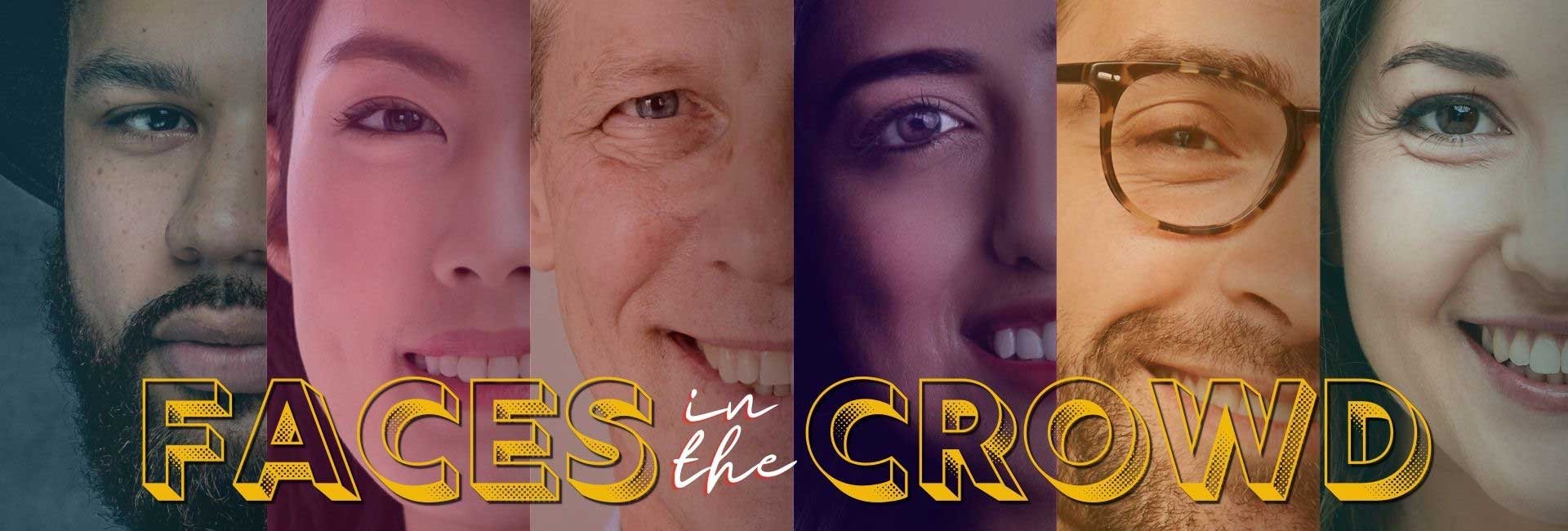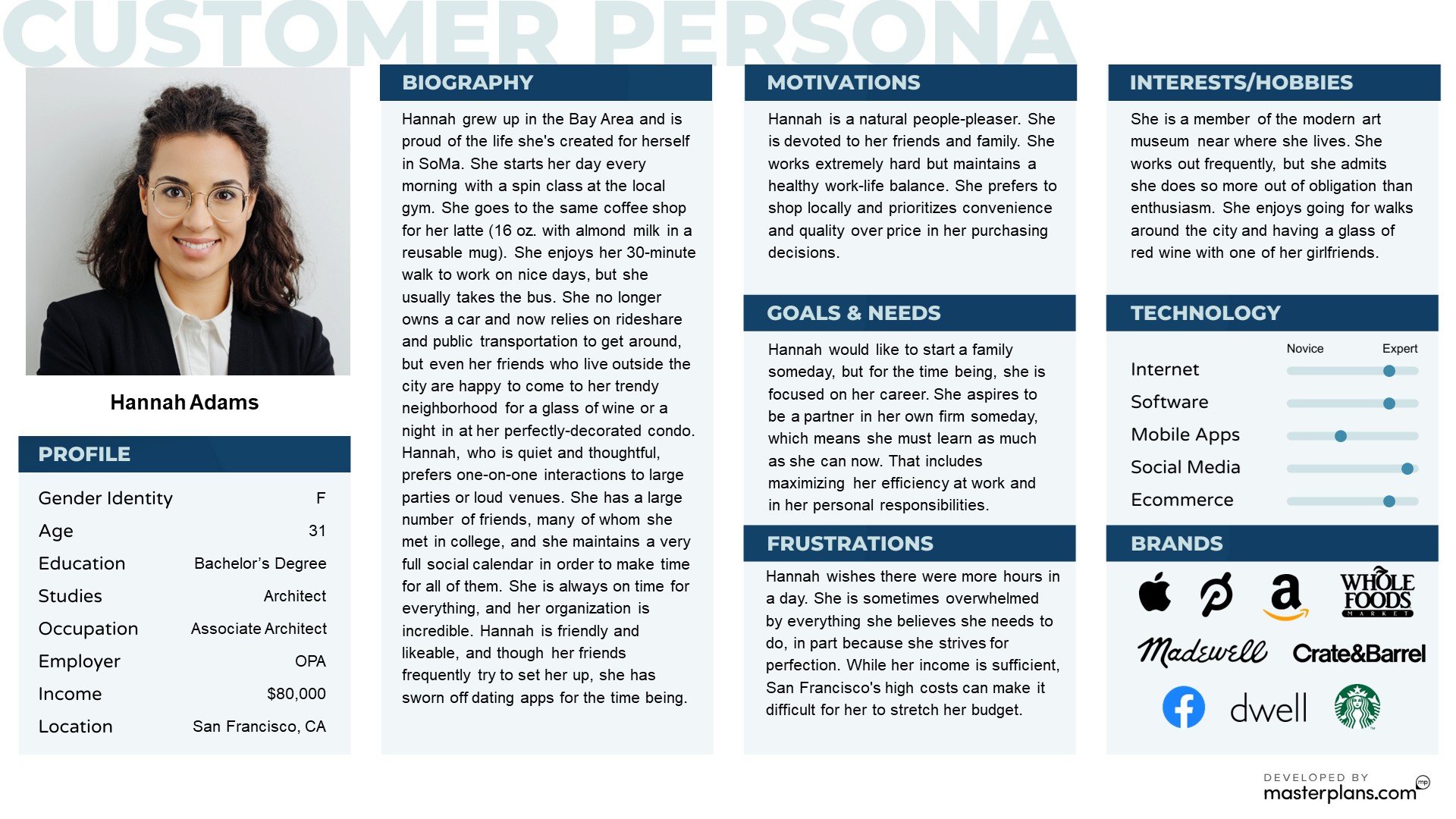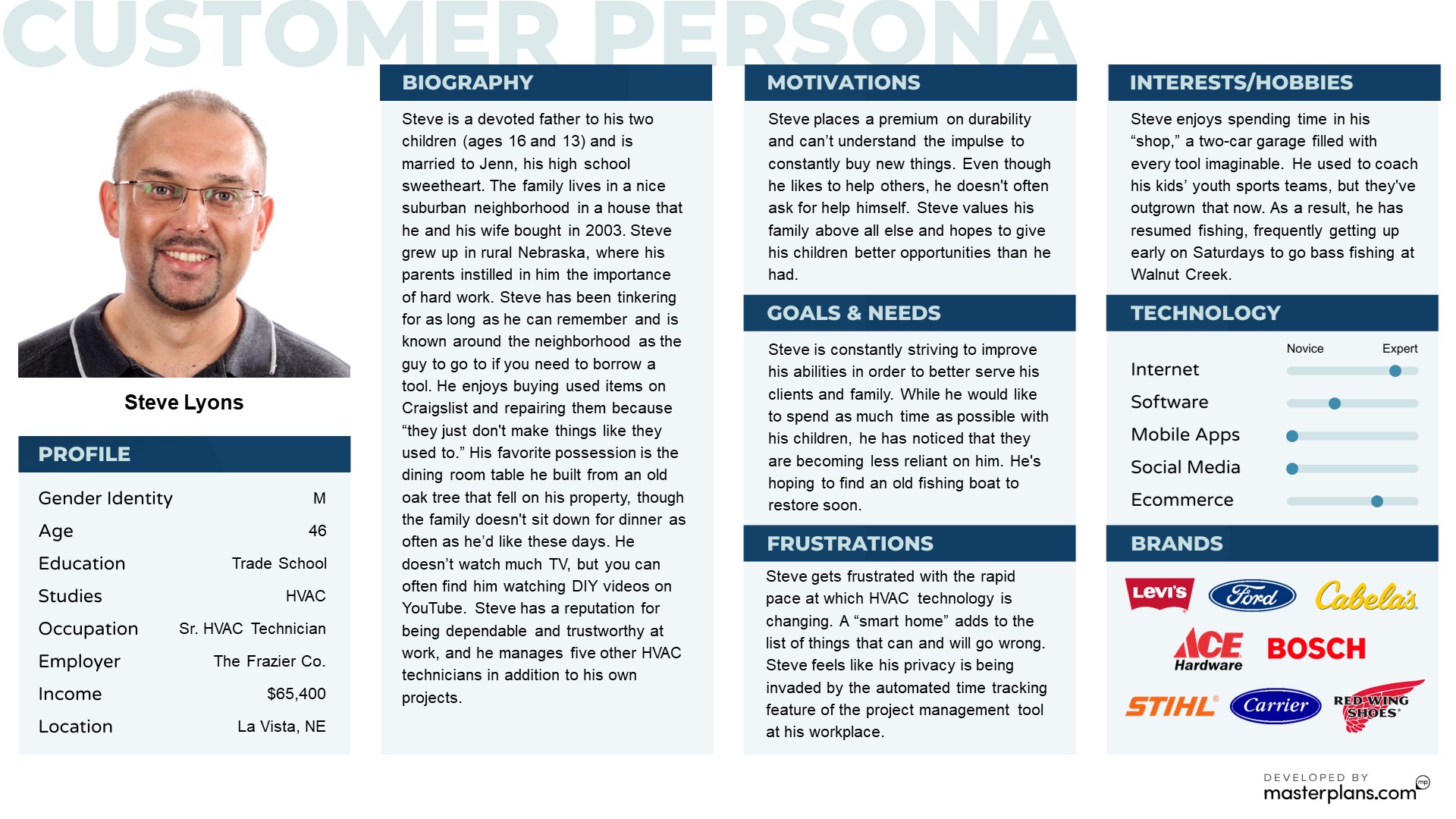
Creating Customer Personas
Bring your buyers to life by downloading our free template, examples, and writing prompts
A customer persona, also referred to as a buyer persona, is a detailed description of a person who represents your target audience.
Rather than paint your target audience with a wide brush, a customer persona gets you to create a fictional character that helps you understand what makes them tick.
A business should create different buyer personas for each of their primary market segments; most companies will have three to four of them. As you develop a customer persona, you’ll uncover interesting things about your target audience, like demographic characteristics, behaviors, and interests, all of which will begin to shape your products and how you market them.
When starting a business, a lot of the upfront planning you need to do is pretty linear. When you’re researching your industry or putting together a financial forecast, there’s not a lot of room to be creative. But customer personas are a place where you can really stretch that creative muscle. Think of yourself as a novelist who is trying to create their protagonist. Your goal is to create a character that’s unique and interesting, but also believable and realistic.
So don’t be afraid to have a little fun putting this together. It’s very likely that your character will go through numerous revisions over time, so don’t feel like it has to be perfect from the start.
Customer Persona Examples
Click on the thumbnails below to view an example of a customer persona.

Free Customer Persona Template
Complete the form below we will email you our editable customer persona template (in PDF and PPT file formats).
How To Write A Customer Persona
Since you will likely create multiple characters, it’s good to have some range between them. Of course, if you’re starting a bar, there’s no point to creating a character younger than 21, but you should still try and create an age range. So when starting out, maybe you think of your broad demographic targets like age and gender.
Photo & Profile
There’s no specific order you need to follow, but sometimes it’s easiest to start with a photo. Just by looking at a picture of a person, you can begin to weave the character together. And you don’t need to worry too much about the photo you pick because it can and likely will change later. Next, begin with some basic profile information, such as name, age, and location.
There are a few philosophies on how to name a persona. Usually, it’s best to give them a believable first and last name, as it begins to make you think of them as a real person. However, others find it easier to give them a nickname, like High-Achieving Hannah or Shop-Master Steve. This naming technique can be helpful when you are trying to quickly differentiate between multiple personas later. Here are the questions that you will need to answer as part of the profile section of the persona:
- What is their name?
- What gender do they identify with?
- How old are they?
- What is their education level?
- What did they study in school?
- What is their current occupation?
- Who is their employer?
- What is their income?
- Where do they live?
Biography
Now that we’ve created a basic profile, we want to build a more descriptive biography. The goal is to create a backstory that fits together in a meaningful and unique way. Do your best to get beyond surface-level stereotypes to create a rich and realistic character.
- Do they have a family?
- What is their relationship status?
- Where did they grow up?
- What was their childhood like?
- What is their personality like?
- Are they impulsive or cautious?
- What has their career path been like?
- What is their current job like?
- What is their management style?
- How big is the company they work at?
- What causes do they support?
Motivations
The next part of the persona is to look at what drives behavior, particularly when it comes to purchasing decisions. On a basic level, humans seek survival, so if your product is food or shelter, you’re off to a good start. Other motivations include security, belonging, status, growth, and altruism. When it comes to buying, customers can be motivated by price, convenience, quality, brand, and experience.
- What do they value in their personal or professional life?
- How do they measure success?
- How much do other people’s opinions matter to them?
- What’s important to them when it comes to making a purchase?
- What objections might they have when making a purchase?
- Are they price sensitive, or do they prefer superior quality?
- Do they prioritize convenience?
- How important is customer experience to them?
Goals & Needs
Think about the last thing you bought. Odds are, whether you realized it at the time or not, you were purchasing something because you needed it. Sometimes, a product fills an immediate need, like grabbing a quick snack. Other times, the product or service is helping your customer achieve a long-term personal or professional goal.
- What are their personal & professional aspirations?
- What challenges do they face that prevent them from achieving their goals?
- What prompts them to find solutions to their problems?
- Why do they need your product or service?
Frustrations
There are many things that bring us frustration on a daily basis: getting stuck in traffic, misplacing your house keys, dealing with a head cold, etc. But beyond the things that frustrate everyone, your customers have their own unique pain points, and hopefully your product or service can aim to solve them.
- What resources do they lack (time, money, access)?
- What problems are they trying to solve?
- What causes them stress?
Interests/Hobbies
No character would be complete without interests and hobbies. By now, you’ve probably stumbled upon a few of them as you wrote the bio or goals sections. In fact, it’s ok to take something you wrote in the bio and move it here, especially if it leaves you more space to add more to their backstory.
- What organizations do they belong to?
- How do they socialize?
- Where might you find them on their day off?
- What is their ideal vacation spot?
- What are they curious to know more about?
- Do they have any unique or special skills?
Technology
When trying to sell a product or service to a customer, you need to know how to reach them. In our template, we’ve separated out several types of media usage so you can gauge how you might market to them. A tip for using our template: When adjusting the sliders, it’s easiest to use the directional arrows!
- Where do they get their information?
- How do they communicate?
- What social media platforms do they use?
- How do they feel about technology?
- Are they inclined to buy online or visit a store?
Brands
We can learn a lot about a person from the brands they support. The things they buy can tell us a lot about who they are as people and provide us with marketing ideas.
- What kind of car do they drive?
- What tech products do they love?
- What do they use to pursue their hobbies and interests?
- What restaurants or stores do they frequent?

Free Customer Persona Template
Complete the form below we will email you our editable customer persona template (in PDF and PPT file formats).




